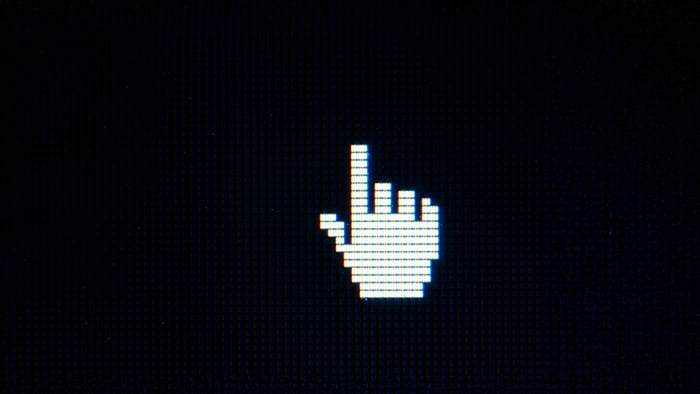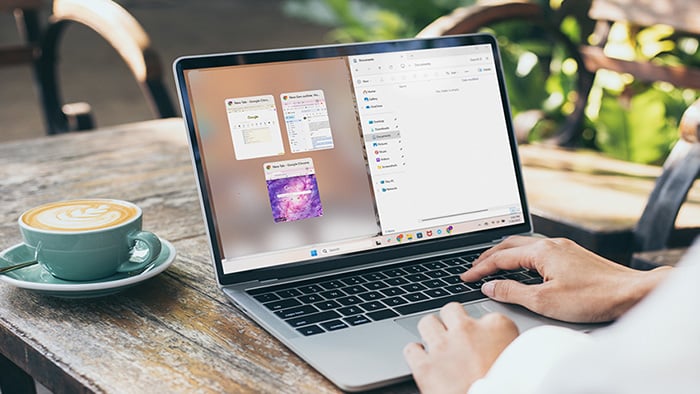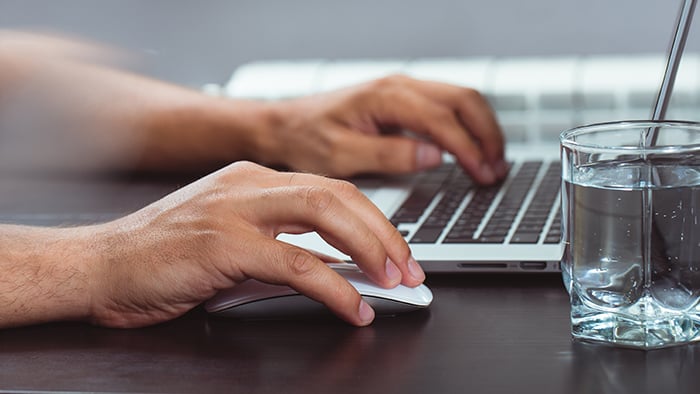An overworked fan is a sure sign of an overheating MacBook, but the potential problems for your machine go way beyond irritating noise. Spinning fans will drain your Mac’s battery in no time, and sustained overheating is likely to cause long-term damage to key internal components.
Keeping your machine running cool is vital for preserving battery health and improving all-round performance.
Why does my Mac get so hot?
Software and hardware issues alike can cause MacBooks to overheat. Although older machines tend to run hot more often, even the latest MacBook models will heat up when memory-intensive tasks overburden the processor, or when internal fans malfunction.
Here are some of the most common reasons why your MacBook Pro may be getting hot or your MacBook Air is overheating:
-
Too many processes and applications running at once. Multiple high-energy programs can max out your MacBook’s processing capacity, causing it to overheat as it struggles to keep up.
-
Unresponsive applications. When Mac apps freeze, crash, or otherwise stop working correctly, they guzzle energy and memory as your Mac attempts to resolve the error.
-
Too many browser tabs open. Each browser tab you keep open is a drain on your MacBook’s resources that can overload the system.
-
SMC fault. The SMC (System Management Controller) is a chip that controls hardware components, including the internal fans which help keep your MacBook at a safe and stable temperature.
-
Defective internal fans. MacBook Pros and MacBook Airs have inbuilt cooling systems to regulate heat. Persistent overheating may indicate a hardware issue with the fans themselves.
-
Blocked air vents. Internal components cannot function properly if the air vents are covered or clogged, preventing the circulation of cool, fresh air.
-
Outdated software. Outdated operating systems and other software may contain bugs or inefficiencies which cause your MacBook to overheat.
-
Viruses or other malware. If your MacBook has a virus covertly running intensive background processes, this could explain why your Mac is overheating.
How to stop your MacBook from overheating
Your MacBook could be running hot due to a number or combination of issues. Work through the following quick and easy steps to keep your MacBook cooling efficiently — and enjoy smooth, slick, and silent performance.
Check the CPU
The CPU (central processing unit) is the engine running your Mac — the harder it works, the more heat it generates. When the CPU is overloaded for sustained periods, it’s almost certain to result in your MacBook heating up. That’s why checking your CPU should be your first step when fixing temperature regulation problems on a MacBook Pro or MacBook Air.
-
Open up Finder and locate the Activity Monitor tool within the Utilities folder of the Applications section.
/img_01.png?width=1006&name=img_01.png)
-
Launch Activity Monitor and click the CPU tab to see which applications are consuming the most processing resources, indicated in the % CPU column.
/img_02.png?width=869&name=img_02.png)
-
Use the X button to shut down intensive processes and reduce the load on your CPU.
-
While you’re in Activity Monitor, switch to the Memory tab to check out your RAM consumption, as this may be hampering performance.
To help reduce the workload on your CPU in the future, consider uninstalling unwanted Mac software to prevent high-impact background processes from swamping your system.
Close unnecessary browser tabs
Dozens of open browser tabs can overwork your MacBook, especially if you’re running other resource-hungry software at the same time. Close any tabs you’re not actively using to reduce your Mac’s workload and help stop your Mac from getting too hot. Along with clearing your cache, tab management can help speed up your browser.
Some of the best browsers, including Avast Secure Browser, come with a handy Task Manager tool that helps you identify and shut down tabs draining high amounts of CPU and memory resources. Bookmark any tabs you may need to access again soon — there’s no need to trade convenience for performance.
Manage your graphics settings
If your MacBook Pro is heating up, you may need to adjust your graphics settings. Some older 15-inch and larger MacBook Pro models are equipped with two graphics cards (GPUs) — one more powerful and resource-hungry than the other.
The more powerful graphics card (the discrete GPU) is great for gaming and rendering video, but it uses more energy, drains your battery faster, and may contribute to overheating. The other card (the integrated GPU) uses less energy, optimizing battery life.
To find out which graphics card you have, go to the Apple menu in the upper-left and select About This Mac.
/img_03.png?width=600&name=img_03.png)
For more info about your graphics processor, click System Report… at the bottom of the About This Mac window and select Graphics/Displays on the left navigation panel.
/img_04.png?width=1626&name=img_04.png)
To enable automatic graphics switching, open up System Preferences and navigate to Battery.
/img_05.png?width=600&name=img_05.png)
In the Battery window, click Power Adapter or Battery on the left to adjust settings for each power mode. If you have two graphics systems in your Macbook, select the Automatic graphics switching tick-box, and your MacBook will intelligently switch between graphics modes to balance performance and resource management.
If the automatic graphics switching option isn’t there, you have only one graphics system on your MacBook Pro.
/img_06.png?width=600&name=img_06.png)
Reset the SMC
A problem with the SMC (System Management Controller) will affect the physical parts of your MacBook, like the fans needed to keep internal components cool.
Fortunately, resetting the SMC is a safe and straightforward fix, and will often solve chip errors that are causing your MacBook Air or Pro to heat up. To reset the SMC follow these three steps:
-
Shut down your MacBook.
-
Press and hold the Shift + Option + Control + Power buttons for 10 seconds.
-
Power your Mac back on normally.
Keep your MacBook updated
Updating your MacBook with the latest operating system has many performance and security benefits and can also combat overheating. Each new macOS version fixes software glitches and inefficiencies, making your Mac run faster, more smoothly, and with less energy impact.
To check which version of macOS you have on your MacBook, open System Preferences, and click Software Updates. If an update is available, click Update Now and your MacBook will take care of the rest.
/img_07.png?width=600&name=img_07.png)
Besides regularly updating your software, periodically defraging your Macbook is another quick and simple way to prevent age catching up with your machine.
Use official Mac chargers only
If you’re using an unbranded, fake, or otherwise defective charger, it’s unsurprising that your MacBook gets hot when charging. In the long term, this isn’t just likely to damage your Mac, but it may be a health and safety hazard. Use official chargers from authorized Apple vendors.
Test your MacBook’s fans
MacBooks overheating and fan noise go hand in hand — excessive fan noise may indicate that your MacBook’s fans aren’t working effectively. Cooling fans are vital for keeping temperatures in check, but if your MacBook Air or MacBook Pro fan won’t stop spinning, there’s likely something wrong.
Here’s how to use the Apple Diagnostics tool to test your Mac’s performance for hardware errors with the fans themselves:
-
Plug your MacBook into a power source and disconnect all other peripherals.
-
Restart your machine, then press and hold the D key while it reboots to launch a hardware scan. The results will be displayed on your screen when the scan is complete.
-
A PFF error code in the results means there’s some kind of fault affecting your fan, and you’ll need to take your MacBook to an Apple-authorized service provider to get it fixed.
Don’t block the air vents
Laptop computers need ventilation to prevent overheating, because their internal components are packed so close together — and MacBooks are no different. Ultra-thin notebooks such as the MacBook Air are particularly sensitive, but MacBook Pro air vents should also be left clear as well.
Built-in fans need cool air to circulate, so blocking the air vents practically guarantees that your MacBook will overheat. Whenever possible, avoid placing your Mac on a soft surface such as a bed, or your lap, as this is likely to smother the vents in the rear screen hinge. Instead, hard and flat surfaces are ideal for maintaining airflow.
Minimize multitasking
Even a brand-new MacBook Pro has a finite amount of computing power. If you push it to the limit by using several high intensity apps at once and for extended periods of time, your system won’t be able to cope with the excess heat generated by the CPU.
Even low-impact applications can be problematic if enough of them are stacked on top of one another. Minimizing the number of active processes goes a long way toward regulating your MacBook’s temperature. It’s also better to shut programs down completely if they’re not in use, rather than leave them running in the background.
Physically clean your Mac
Over time, dust and other detritus inevitably accumulates within your MacBook, clogging up sensitive hardware components. Sometimes a little spring cleaning is all that’s needed to get your MacBook Pro or MacBook Air running smoothly again.
To clean your computer safely and effectively, remove the bottom panel (if possible) to access the nuts and bolts of your machine. Use a can of compressed air to clear away any debris lodged in the ventilation ducts or the fan itself. Then carefully wipe away any other dirt with a lint-free cloth.
Remember, it isn’t just physical junk that you need to worry about. Digital dross also contributes to overheating, which is yet another reason why using top-of-the-line cleaning software to clean up your MacBook is so important for keeping it in peak condition.
Protect your MacBook with strong security software
Besides the risk they pose to your MacBook’s privacy and security, Mac viruses and other types of malware infecting your Mac can cause all manner of performance issues, from corrupted software and reduced memory, to sluggish processing and overheating.
Certain Trojans and spyware run high-impact processes without your knowledge, which could explain why your Mac is getting hot for no apparent reason. If you suspect malware has commandeered your machine, take steps to remove any viruses from your Mac and neutralize ransomware immediately. Then, install robust security software to keep your MacBook safe and your data secure.
Keep your Mac running smoothly with Avast Cleanup
The best way to manage overheating and related performance issues is to use a dedicated cleanup tool that optimizes your MacBook’s performance and clears out everything you don’t need — ensuring there’s plenty of power left for your digital lifestyle.
Avast Cleanup for Mac is specially engineered to unlock the full potential of your MacBook Pro or MacBook Air. Its intuitive toolkit helps you lighten the load by ditching junk files and programs at the click of a button. And it’ll even intelligently balance your background CPU and memory usage for cooler, safer, and smoother performance.
/Academy-Why-your-Mac-is-overheating-and-how-to-fix-it-Hero.jpg?width=1200&name=Academy-Why-your-Mac-is-overheating-and-how-to-fix-it-Hero.jpg)
/img_01.png?width=1006&name=img_01.png)
/img_02.png?width=869&name=img_02.png)
/img_03.png?width=600&name=img_03.png)
/img_04.png?width=1626&name=img_04.png)
/img_05.png?width=600&name=img_05.png)
/img_06.png?width=600&name=img_06.png)
/img_07.png?width=600&name=img_07.png)











